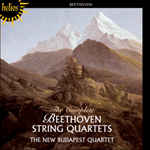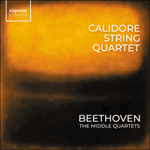
Welcome to Hyperion Records, a British classical label devoted to presenting high-quality recordings of music of all styles and from all periods from the twelfth century to the twenty-first.
Hyperion offers both CDs, and downloads in a number of formats. The site is also available in several languages.
Please use the dropdown buttons to set your preferred options, or use the checkbox to accept the defaults.

| Calidore String Quartet» More |
The semitone E-D sharp is crucial towards the end of the first movement, and it begins the very different Adagio. The semitone is also the basis of the very intense climactic harmonization of the slow movement's main theme, highly chromatic but entirely without self-indulgence.
In the third movement Beethoven avoids his 'normal' scherzo (in fact none of the Razumovsky Quartets has a typical Beethoven scherzo), instead producing an Allegretto in which the semitonal phenomenon is again pervasive. There is a twice-heard Trio in E major, where the requested 'Thème Russe' occurs. As in the F major Quartet, Beethoven perpetrates a joke on the dedicatee — the Russian tune is stately and dignified (think of the Coronation Scene in Mussorgsky's Boris Godunov where it is magnificently used) but Beethoven treats it skittishly, even subjecting it to rough counterpoint that doesn't 'work', before atoning with an exquisite softening of the blow.
The C major that invaded the first movement's development now begins the wildly Slavic finale and almost succeeds in rendering the main key of E minor unstable. Every time the first theme recurs, C major, not E minor, is prepared, and at length Beethoven, with wry humour, makes the movement seem to run away from the effect: 'No - not that again! ' All this is a splendidly imaginative way of preventing the wrong kind of monotony when all four movements are in the same key, minor or major. Curiously enough, the four important works of Beethoven in the key of E minor or major (the others are all piano sonatas — Op 14 No 1, Op 90, and Op 109) all have this monotonal design.
from notes by Robert Simpson © 1991
Vers la fin du premier mouvement, le demi-ton mi-ré dièse est crucial, et il commence l'adagio qui est très différent. Ce demi-ton est aussi la base de la très intense harmonisation à l'apogée du thème principal du mouvement lent hautement chromatique mais sans excès.
Dans le troisième mouvement, Beethoven évite son scherzo 'habituel' (en fait, aucun des quatuors Razumovsky n'a de scherzo typique de Beethoven); il donne à sa place un allegretto dans lequel le phénomène de demi-ton se retrouve à nouveau, avec son influence pénétrante. Il y a le Trio en mi majeur répété, où se trouve le 'thème russe' demandé. Comme dans le quatuor en fa majeur, Beethoven joue un tour à celui à qui le morceau est dédié — l'air russe est majestueux et grave (il est utilisé de façon magnifique dans la Scène du Couronnement du Boris Godounov de Moussorgsky) mais Beethoven le traite avec espièglerie, allant jusqu'à le soumettre à un contrepoint brusque qui ne 'marche' pas, avant de se racheter en atténuant le choc de façon exquise.
L'ut majeur qui envahissait le développement du premier mouvement commence maintenant le finale fiévreusement slave et réussit presque à déstabiliser le ton principal de mi mineur. Chaque fois que le premier thème apparaît, ut majeur, et non mi mineur, est là, et à la fin Beethoven, avec un humour ironique, semble laisser le mouvement se lasser de cet effet: 'Non, c'est assez'. Tout ceci est un moyen merveilleusement imaginative d'obvier à une fausse sorte de monotonie quand tous les quatre mouvements sont dans le même ton, mineur ou majeur. Il est curieux de remarquer que les quatre ouvrages importants de Beethoven dans le ton de mi mineur ou majeur (les autres sont tous des sonates pour piano — op 14 no 1, op 90 et op 109) sont tous écrits selon ce plan monotone.
extrait des notes rédigées par Robert Simpson © 1991
Français: Alain Midoux
Das Halbtonintervall E-Dis ist gegen Ende des 1. Satzes entscheidend, und mit ihm setzt das ganz anders geartete Adagio ein. Das gleiche Intervall dient auch als Basis der hochintensiven klimaktischen Harmonisierung des Hauptthemas im langsamen Satz, die stark chromatisch und doch keineswegs zügellos ist.
Im 3. Satz verzichtet Beethoven auf das 'übliche' Scherzo (in der Tat besitzt keines der Rasumowski-Quartette ein typisch Beethovensches Scherzo) und bringt stattdessen ein Allegretto, das wiederum von dem Halbtonphänomen beherrscht wird. Im zweimal dargebotenen Trio in E-Dur kommt das verlangte 'Thème Russe' vor. Wie beim F-Dur-Quartett erlaubt sich Beethoven einen Scherz mit Fürst Rasumowski — das russische Motiv ist getragen und würdevoll (man denke an die Krönungs-szene von Mussorgskis Boris Godunow, wo es in voller Erhabenheit eingesetzt wird), aber Beethoven geht ungebärdig damit um und setzt es sogar grober, nicht 'funktionierender' kontrapunktischer Behandlung aus, ehe er mit einer wunderbaren Zurücknahme des Schocks einlenkt.
Die Tonart C-Dur, die sich in die Durchführung des 1. Satzes eingeschlichen hatte, beginnt nun das ungestüm slawische Finale und schafft es beinahe, die Haupttonart e-Moll aus den Angeln zu heben. Jedesmal, wenn das 1. Thema auftritt, wird C-Dur anstelle von e-Moll vorbereitet, und Beethoven scheut keine Mühe, mit sarkastischem Humor den Anschein zu erwecken, als renne der Satz vor diesem Effekt davon: 'Nein - nicht schon wieder!' All dies ist eine höchst originelle Methode, die falsche Art von Monotonie zu verhindern, wenn alle vier Sätze in der gleichen Dur- bzw. Molltonart stehen. Eigentümlicherweise haben die vier bedeutenden Werke Beethovens in den Tonarten e-Moll oder E-Dur (die übrigen sind Klaviersonaten, nämlich op. 14, Nr. 1, op. 90 und op. 109) samt und sonders diesen monotonalen Aufbau.
aus dem Begleittext von Robert Simpson © 1991
Deutsch: Anne Steeb/Bernd Müller
 Beethoven: String Quartets Beethoven: String Quartets‘Fine performances, always intelligent, with many considerable insights … perfect intonation and excellent ensemble and tonal blend, with first-c ... ‘Very fine … I enjoyed these performances because they deliver Beethoven as I want him, free of the biographical sensationalism. Highly recommend ...» More |
 Beethoven: The middle quartets Beethoven: The middle quartetsFive glorious string quartets dating from late in Beethoven's prodigious 'middle' period: the three 'Rasumovskys' from 1806, Op 74 from 1809 and from the following year Op 95, one of the most extraordinary distillations of musical thought. These ...» More |

